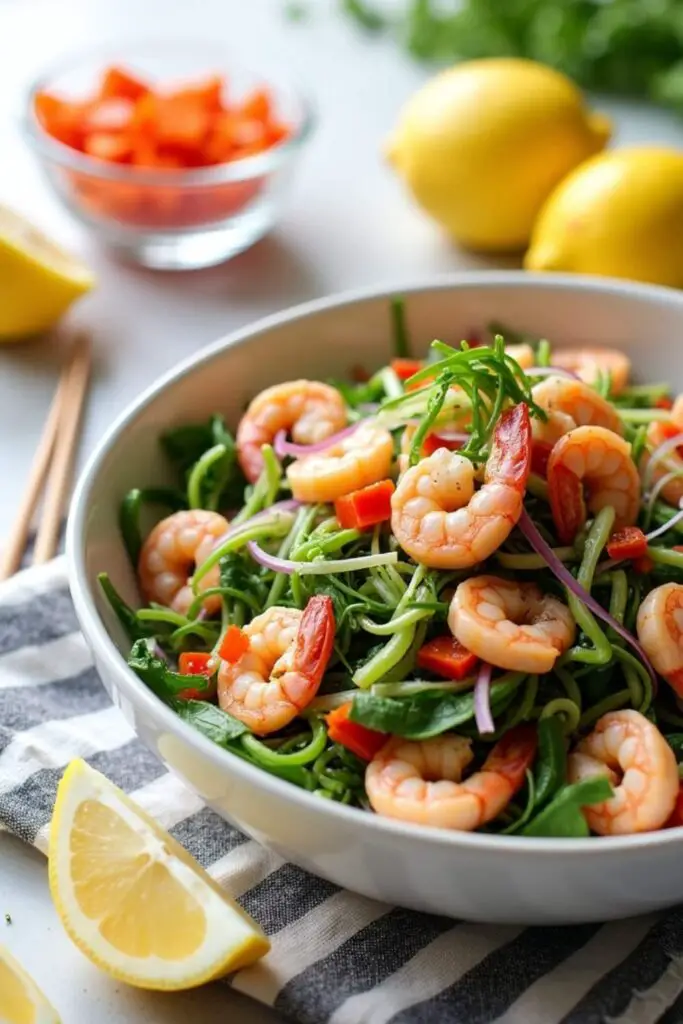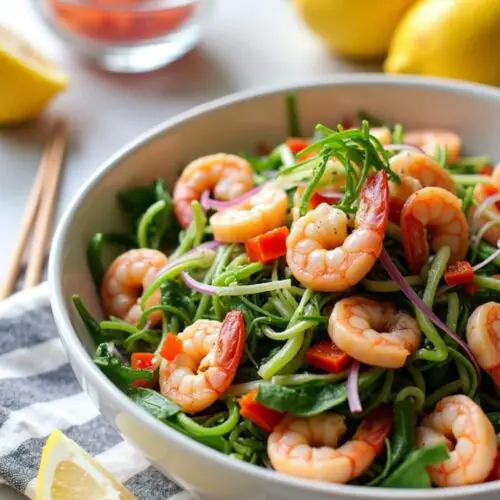Polk salad comes from the young shoots and leaves of pokeweed, a plant native to eastern North America. However, pokeweed contains toxic compounds so it’s important to prepare it safely.
First, only the green shoots less than 6 inches are collected. Then they are boiled two or three times, changing the water each time, which removes any signs of red color indicating toxins.
Once fully cooked in this way, the greens supposedly take on a taste both bitter like spinach but also somewhat similar to asparagus. Some say it’s an acquired taste.
Historically, polk salad served as important food for poor people, especially former slaves and farm families. Since pokeweed grows freely, it provides needed nutrition.
While not widely known today, polk salad remains part of the cuisine in certain parts of the southeastern US. And with renewed interest in foraged foods, its traditional uses may see more appreciation. Just be sure any pokeweed is processed thoroughly for utmost safety.
Is it Polk Salad or Poke Salad?
The dish has historically been known as “poke salad” or the older form “poke sallet”, reflecting its origins as a cooked vegetable medley rather than a raw salad. However, in more recent times, an alternate spelling emerged – “Polk salad”.
It seems this variation gained widespread use following musician Tony Joe White’s hit song “Polk Salad Annie” from 1969. As the song featuring the non-traditional name became popular, so too did this spelling of the dish.
While “poke salad/sallet” reflects the food’s roots, “Polk salad” entered mainstream awareness thanks to White’s catchy country tune. Consequently, both terms exist today.
Pokeweed (Poke Salad) Identification & Safety
What Is Pokeweed (Poke Salad)? Pokeweed, also known as Phytolaca americana, is a perennial plant native to North America. It’s typically found in the wild, but can also be grown in gardens.
When to Harvest Pokeweed: Harvest pokeweed shoots in the spring when they are no more than 6 inches tall. Avoid harvesting mature plants as they contain toxins.
How to Cook Pokeweed: Properly preparing pokeweed is crucial. The plant must be boiled twice to remove toxins. Always discard the water after each boiling to ensure safety.
What Is Polk Salad Good For? Polk Salad is a rich source of vitamins A and C, and it provides antioxidants and minerals. It’s a nutritious addition to your diet when prepared safely.
Polk Salad (poke salad) Ingredients
- Young Pokeweed Shoots (Phytolaca americana)
- White Onion
- Garlic
- Fresh Ginger (optional)
- Olive Oil
- Cherry Tomatoes
- Bell Peppers
- Shrimp
- Soy Sauce
- Sesame Oil
- Black Pepper
Optional Ingredients:
- Rice
- Eggs
Ingredient Notes
Pokeweed Identification: Young pokeweed shoots are small, tender, and bright green. Make sure to harvest them early in the spring before they grow tall, as the mature plant is toxic. Pokeweed leaves are typically large and oval-shaped, while the stems are thick and reddish.
Toxicity Warning: Pokeweed is toxic if not prepared properly. Always make sure to boil the young shoots twice, discard the cooking water, and never consume raw parts of the plant.
How I Made Polk Salad
Step 1: Prepare the Pokeweed Shoots
First, wear gloves to handle the pokeweed shoots, as the raw plant can be toxic. Choose young shoots, no taller than 6 inches, as older plants contain harmful toxins.
Wash the shoots thoroughly and trim off any tough, fibrous parts.
Bring a pot of cold water to a boil and add the shoots. Boil them for 5 minutes to begin removing toxins.
Drain the water and refill the pot with fresh water. Bring it to a boil again and cook the shoots for 30 minutes. Discard the water after cooking, as it may contain toxins.
Allow the shoots to cool, then pat them dry with a paper towel to remove excess moisture.
Step 2: Sauté the Aromatics
Heat olive oil in a large pan over medium heat. Add the chopped onion, garlic, and ginger. Sauté for 3 to 5 minutes until fragrant and the onion becomes translucent.
Step 3: Cook the Shrimp
Add the shrimp to the pan with the onions and garlic. Cook for about 3-4 minutes on each side until they are pink and opaque. Remove the shrimp and set aside.
Step 4: Prepare the Vegetables
In the same pan, add the prepared pokeweed shoots. Stir frequently, ensuring the shoots are well-coated in the oil and seasonings.
Add the bell peppers and cherry tomatoes, cooking for 5 minutes until the vegetables soften slightly but still retain some crunch.
Step 5: Season and Combine
Add the soy sauce, sesame oil, and black pepper to the vegetables and greens. Stir everything together to combine the flavors.
Finally, return the cooked shrimp to the pan and toss to incorporate.
Step 6: Serve
Serve your Polk Salad warm, optionally over a bed of rice. Enjoy the harmony of flavors and textures in this traditional Southern dish.

Pro Tips
Harvest Young Shoots: Only use young, tender pokeweed shoots for this dish. Older shoots contain toxins and should never be consumed.
Multiple Boils: The key to making pokeweed safe is boiling it twice. This removes the toxins and ensures the dish is edible.
Cook Shrimp Just Right: Shrimp cooks quickly, so be sure to remove it from the pan once it’s opaque to avoid overcooking.
Add Crunch: Bell peppers, tomatoes, or even cucumbers provide a nice contrast to the cooked greens and shrimp.
Variations & Substitutes
Vegetarian Option: Substitute shrimp with tofu, tempeh, or beans for a plant-based version of this salad.
Add Eggs: For added protein and richness, top your Polk Salad with a soft-boiled egg.
Use Bacon: If you prefer a smoky flavor, cook bacon and add the crispy bits to the salad instead of shrimp.
Spicy Version: Add fresh or pickled jalapeños for a spicy kick.
Storage Instructions
Leftovers: Store leftover Polk Salad in an airtight container in the refrigerator for up to 2 days. Reheat gently before serving.
Freezing: It is not recommended to freeze Polk Salad, as the texture of the greens and shrimp will change once thawed.
Frequently Asked Questions (FAQs)
1. Is pokeweed poisonous? Yes, pokeweed contains toxic compounds, especially in its mature leaves and stems. However, when prepared properly (by boiling young shoots twice), it is safe to eat.
2. How do I know if pokeweed is safe to eat? Only consume young pokeweed shoots, no taller than 6 inches. Always boil the shoots twice and discard the water to ensure all toxins are removed.
3. Can I eat pokeweed raw? No, raw pokeweed is toxic and should never be consumed. Always cook the plant properly to remove toxins.
4. Can I substitute other greens for pokeweed? Yes, you can substitute pokeweed with collard greens, spinach, or mustard greens if pokeweed is unavailable or if you prefer a non-wild plant.
5. What does pokeweed taste like? When properly prepared, pokeweed has a mild, earthy flavor, similar to spinach but with a unique texture and bite.
More Recipes
- Chicken Salad Without Mayo
- Cucumber Salad Vinegar
- Hot Honey Chicken Salad
- Mexican Tuna Salad
- Caramel Apple Cheesecake Salad

Polk Salad
Ingredients
- Young Pokeweed Shoots Phytolaca americana – Tender, young shoots (less than 6 inches tall)
- 1 medium White Onion finely chopped
- 2 to 3 cloves Garlic minced
- Small knob Fresh Ginger optional, finely minced
- Olive Oil – For sautéing
- 6 to 8 Cherry Tomatoes halved
- 1 large Bell Pepper diced
- 1/2 pound Shrimp peeled and deveined
- 2 tbsp Soy Sauce
- Dash of Sesame Oil
- Black Pepper freshly ground, to taste
Optional Ingredients:
- Rice – To serve as a base
- Eggs – Soft-boiled as desired
Instructions
Step 1: Prepare the Pokeweed Shoots
- First, wear gloves to handle the pokeweed shoots, as the raw plant can be toxic. Choose young shoots, no taller than 6 inches, as older plants contain harmful toxins.
- Wash the shoots thoroughly and trim off any tough, fibrous parts.
- Bring a pot of cold water to a boil and add the shoots. Boil them for 5 minutes to begin removing toxins.
- Drain the water and refill the pot with fresh water. Bring it to a boil again and cook the shoots for 30 minutes. Discard the water after cooking, as it may contain toxins.
- Allow the shoots to cool, then pat them dry with a paper towel to remove excess moisture.
Step 2: Sauté the Aromatics
- Heat olive oil in a large pan over medium heat. Add the chopped onion, garlic, and ginger. Sauté for 3 to 5 minutes until fragrant and the onion becomes translucent.
Step 3: Cook the Shrimp
- Add the shrimp to the pan with the onions and garlic. Cook for about 3-4 minutes on each side until they are pink and opaque. Remove the shrimp and set aside.
Step 4: Prepare the Vegetables
- In the same pan, add the prepared pokeweed shoots. Stir frequently, ensuring the shoots are well-coated in the oil and seasonings.
- Add the bell peppers and cherry tomatoes, cooking for 5 minutes until the vegetables soften slightly but still retain some crunch.
Step 5: Season and Combine
- Add the soy sauce, sesame oil, and black pepper to the vegetables and greens. Stir everything together to combine the flavors.
- Finally, return the cooked shrimp to the pan and toss to incorporate.
Step 6: Serve
- Serve your Polk Salad warm, optionally over a bed of rice. Enjoy the harmony of flavors and textures in this traditional Southern dish.

